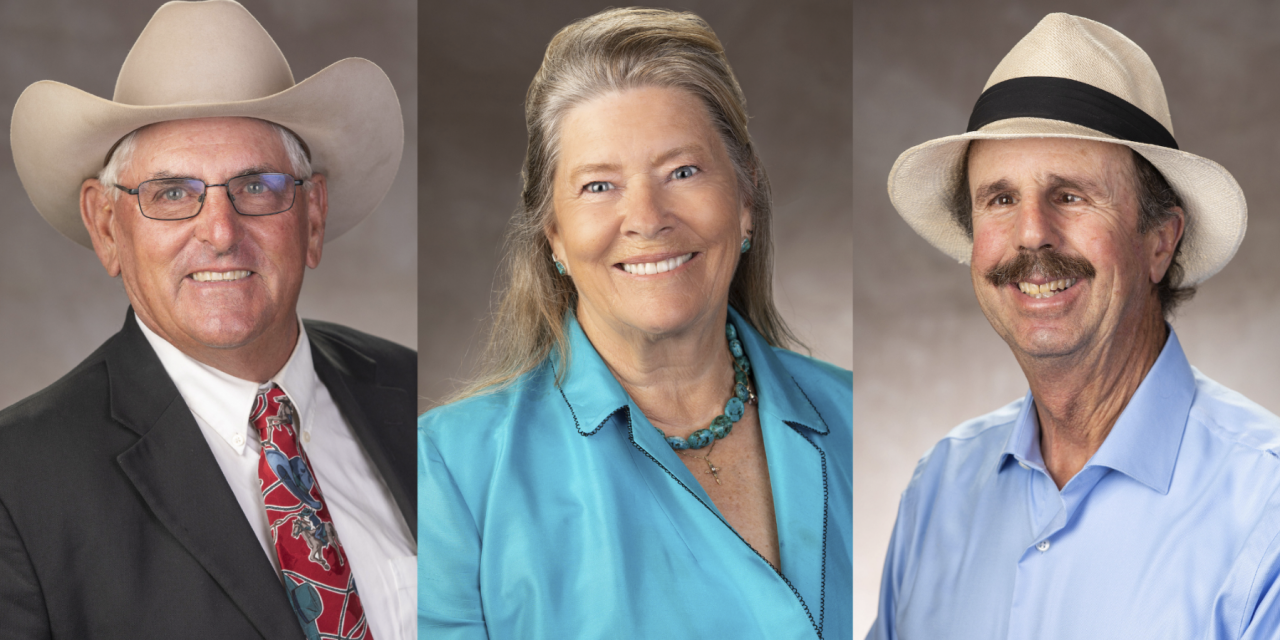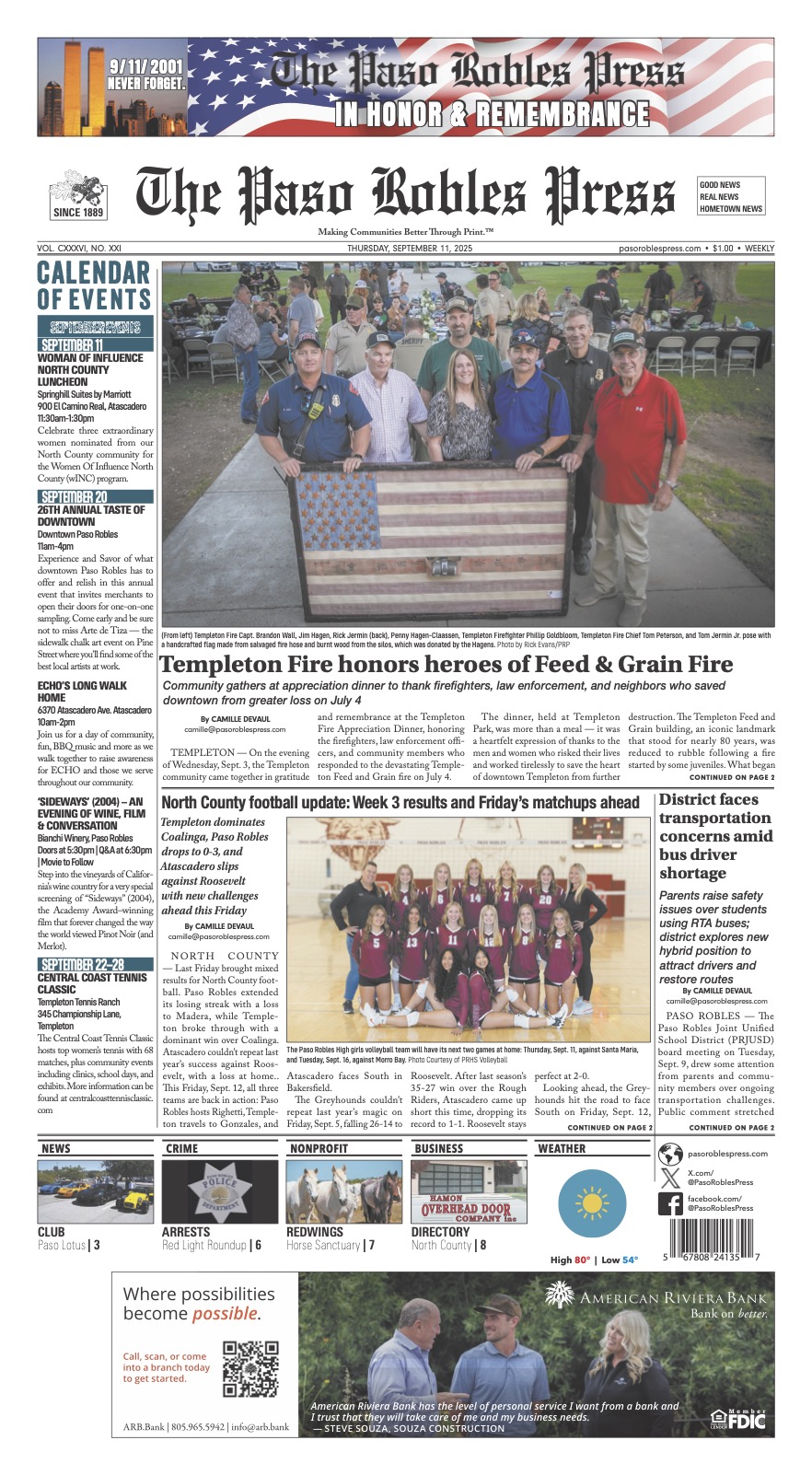Three local farm and ranch leaders honored at California Mid-State Fair Event
PASO ROBLES — Local agriculture organizations recognized three San Luis Obispo County farmers and ranchers during the California Mid-State Fair’s 2020 Night of the Stars Drive-In Awards Ceremony on Thursday, Sept. 24, at the Paso Robles Event Center.
The 2020 award recipients are:
• Lesa John, Cattlewoman of the Year,
• Steve Arnold, Cattleman of the Year, and
• Jerry Rutiz, Agriculturalist of the Year.
The awards were selected by members of the San Luis Obispo County Farm Bureau, San Luis Obispo County Cattlewomen, and the San Luis Obispo County Cattlemen’s Association.
“We are grateful for the contributions these three individuals have made to San Luis Obispo County agriculture,” said Farm Bureau Executive Director Brent Burchett. “Our county’s $2.5 billion agricultural economy is built upon the hard work of farmers and ranchers, and today we are proud to recognize a few of our very best.”
Traditionally, the award winners are announced during the annual Cattleman and Farmers Day at the Mid-State Fair, which had to be canceled in 2020 due to the pandemic.
“Showcasing agriculture is so important to local youth and our community, and we appreciate the efforts of the Mid-State Fair staff and Board of Directors to put this event on in the face of so many challenges,” Burchett added.
San Luis Obispo County Farm Bureau
2020 Agriculturalist of the Year
Jerry Rutiz
San Luis Obispo County Farm Bureau has selected Arroyo Grande farmer Jerry Rutiz as the 2020 Agriculturalist of the Year.
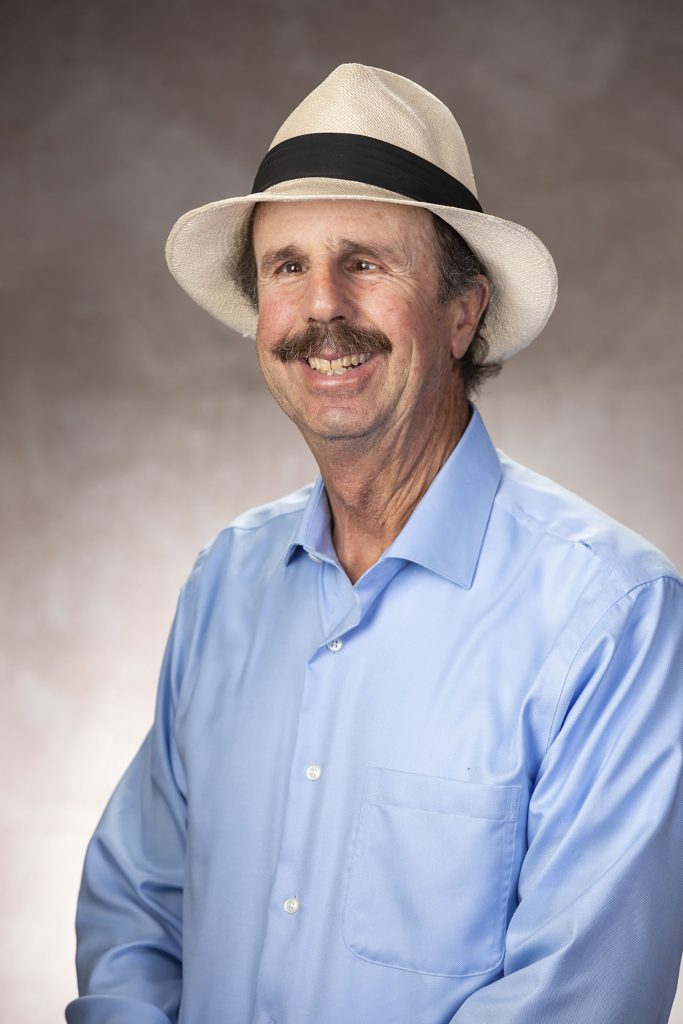
The Agriculturalist of the Year award recognizes distinguished success in the agriculture industry and a lifetime of dedication to advancing San Luis Obispo County’s rich farming and ranching heritage.
“The disruption to our food system caused by the pandemic reminded our community about the importance of locally-grown food,” said Farm Bureau Executive Director Brent Burchett, “and there has been no finer representative of our resilient SLO County food system than Jerry Rutiz.”
A native of the Los Angeles area, Rutiz first came to San Luis Obispo in 1974 to attend Cal Poly, graduating with a Crop Science degree in 1978.
“The ag program back then, probably about half the kids were coming in from farm backgrounds, and the other half were coming from cities like myself,” Rutiz remembered. “We were kind of the hippies.”
His farming enterprise began in 1981 when he was able to lease a small farm in Arroyo Grande as a first-generation farmer. Rutiz said he started out borrowing equipment on nights and weekends from neighboring farmers. “When I finally did get my own equipment, it was used equipment held together with bailing wire.”
Rutiz was an early adopter of marketing produce directly to consumers and an innovator in implementing organic farming practices. After a few years of growing conventional produce and selling through wholesale market channels, Rutiz said it was a call from his mother that changed the trajectory of his farming business.
“Farmers’ markets were just starting, and my mother living in L.A. called me and said, ‘You know Jerry, you really should load up some of your produce and try selling at the market down here.’ I ignored her ideas for several weeks, then finally went down to sell at the Santa Monica market. We sold everything we had in an hour.”
The next week, Rutiz borrowed a bigger truck and sold out at the market again. “On the way home, I’ve got $300 dollars in my pocket – and that was the most money I’d had for three years at any given time -and I’m thinking, maybe there’s something to this direct marketing!”
As farmers’ markets and the farm-to-table movement increased in popularity throughout the Central Coast and Southern California, Rutiz Family Farms became celebrated for having a diverse, quality selection of produce.
“There were other farms there, but I was unique. I learned early on I had to diversify and grow different things rather than just going down to L.A. with cabbage and sugar peas like most of the other farmers were doing. Soon, I was bringing 30 to 40 different items to the market, and that’s how we succeeded down there and later at new markets in SLO County.”
Interfacing directly with consumers at the market, Jerry and his wife Maureen sensed an opportunity to differentiate their produce by switching to organic farming methods. “Customers would tell us they’d be much happier if we weren’t spraying stuff, so I took it upon myself to find out how we can farm without spraying pesticides,” Jerry recalled.
Transitioning to organic production was not easy. “You don’t go cold turkey” from conventional to organic, Rutiz explained. Maureen added that while customers didn’t want spraying, “they would complain about the arugula having tiny bug holes, and I would just say, the holes don’t hurt you.”
After becoming a fixture at farmers’ markets, Rutiz’s reputation grew as a number of prominent chefs began to feature his crops on their menus, and his farm was frequently profiled in media outlets like the L.A. Times. Jerry and his produce also received national exposure on the PBS television series Moveable Feast with Fine Cooking.
“These are the high-end restaurants down in L.A. that serve you one carrot for $5 or something,” Rutiz clarified with a laugh. “They would put the carrot on their menu and say, ‘Jerry’s carrot from Arroyo Grande.’”
Though grateful for making a living selling at farmers’ markets, Rutiz conceded the rigor of covering multiple locations across the region “took a physical and emotional toll.” In 2003, an opportunity emerged to tend a 28-acre farm in Arroyo Grande owned by the Temple of the People of Halcyon. The farm’s location, surrounded by a residential area, was particularly suited to accommodate Jerry’s long-held dream of operating a farm stand. What started as “a table made from two sawhorses and a piece of wood” transformed into a thriving business with a large local customer base, and the Rutiz’s gradually travelled to fewer markets as the farm stand business grew.
Today, the Rutiz’s stand offers produce, berries and cut flowers grown on the farm, supplemented with over a dozen food and farm items from local businesses. It’s common to see a line of smiling, eager customers queued up on Tuesday-Saturday, and though he could probably sell them, you won’t find any five-dollar carrots.
“I look at what my cost of production is, what it has to cost to pay a fair wage to my employees and for us to make a fair living off of it,” Jerry offered. “That’s how I’ve always priced my produce. I’ve never looked at it as, what can I get, what’s the maximum.”
Jerry said the farm is ideally located to showcase local agriculture to the public. “We are a rural-urban interface, and we look at our proximity to residences as an asset,” he emphasized. He’s hosted countless tours for youth, from preschoolers to Cal Poly students, and field-to-table cooking events with local chefs and food influencers. “I feel that we strive to make the connection with the community, to make this their farm.” The Rutiz’s outreach is apparent; Rutiz Family Farms was voted “Best SLO County Farm/Produce Stand” in 2020 and in nearly every SLO New Times Annual Readers Poll.
Jerry and Maureen are the proud parents of two adult daughters, Julianne and Moira, and their dog Emma. San Luis Obispo County Farm Bureau has given the Agriculturalist of the Year award annually since 1988, making Rutiz the 32nd person to receive this honor.
San Luis Obispo County Cattlewomen
2020 Cattlewoman of the Year
Lesa John
The San Luis Obispo County Cattlewomen have selected Lesa John of Paso Robles as the 2020 Cattlewoman of the Year.
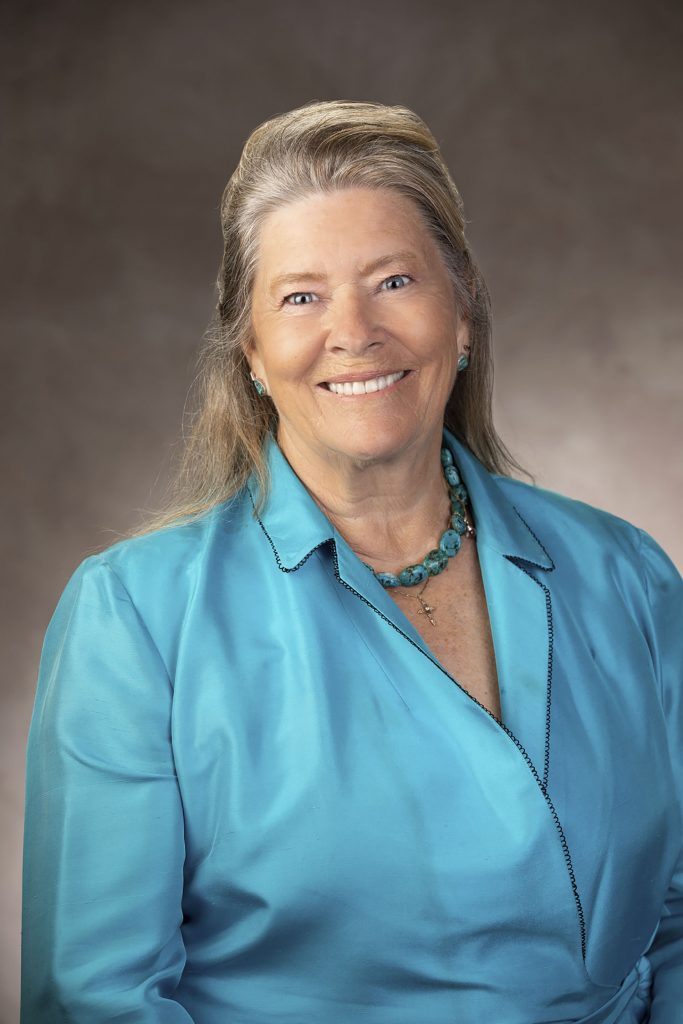
A longtime community volunteer and advocate for the local cattle industry, Lesa John first became a SLO County Cattlewomen’s member in 1976, having been a member in Monterey County since the early 1970s.
“I am incredibly honored, humbled and grateful to be recognized by women who so deeply respect and believe in the generations of ranching and farming in San Luis Obispo County,” John said.
Lesa John was born in Yakima, Washington to World War II U.S. Navy veteran Gyle Halverson and music teacher Harriet (Lee) Halverson in 1949. Her father helped start the Culligan Soft Water Service company, so much of Lesa and her three brothers’ childhood was spent moving around the western United States with her father’s work.
She first fell in love with the ranching way of life in 1967 hanging out with her best friend Jackie Carr Hoover at the Carr Ranch in Contra Costa County, California. After graduating from Campolindo High School, she attended Diablo Valley Junior College and was a receptionist part time at the Sun Valley Mall. In 1969, she attended Cal Poly, San Luis Obispo majoring in Child Development. She met her first husband, Kim Wood, who is from a longtime ranching family in the Bryson-Hesperia area of Monterey County.
Lesa John passed along her passion for ranching to her three children, Tania Leanne, Tyler Joshua, and Misty Dawn. Both her daughter Tania and son Tyler Joshua graduated with agriculture degrees from Cal Poly and went on to have careers in horse training, and welding and cattle ranching, respectively. Misty, a Registered Nurse, and her husband Derrick Tartaglia operate their cow-calf operation in Harmony, California, while Derrick also helps manage the cattle operation for Hearst Ranch in San Simeon. Lesa said she is “so proud of her grandchildren Chance Whitman and Reese and Tanna Tartaglia who are all ranch-raised.”
Her decades of volunteer service to the San Luis Obispo County Cattlewomen first began in 1988 when she moved to Atascadero. She and Kim started and ran Agri-Wood Feed & Ranch Supply and Longhorn Beef Jerky businesses. After selling Agri-Wood, she worked at Atascadero News, Atascadero Chamber of Commerce with Maggie (Rice) Vandergon, and the Atascadero School District.
In 1992, Lesa was hired by Maynard Potter and Vivian (Sayler) Robertson at the California Mid-State Fair. Lesa was a fixture at the Fair, having assisted Beverley Wood with the Horse Show for many years and managing commercial concession operations for 22 years.
In 1994, she married Derryal John at the Chapel on the Hill in Shandon. Derryal and Lesa were married for 25 years until his passing in January of 2020. Derryal planted and managed several San Luis Obispo County vineyards and was a nominee for Grower of the Year. Lesa is the proud stepmom of Will John, a vineyard owner and manager, and Bridgette John, who is in the food service industry in Las Vegas, and her grandchildren Quinn, Delaney, and Lilli John, who “all have buckles for showing sheep at the California Mid-State Fair!”
Today, Lesa remains active in the local community. She serves as treasurer of the Honor Flight Central Coast California. Her distinguished service to the San Luis Obispo County Cattlewomen has included a number of committee positions and leadership roles, including Special Olympics representative, Pioneer Day Roping Committee, Cowbelle Trailriders, Valentine’s Dance, and the Casino Night fundraiser. She has conducted countless beef cooking demonstrations for students at Cal Poly and Atascadero High School. In her spare time, Lesa said she enjoys being “Grammy” and visiting her family in Washington, Oregon, South Dakota and Oklahoma.
Lesa has embraced her role advocating for agriculture. “My initial reaction to being named Cattlewoman of the Year was, I don’t deserve it, I don’t even own a cow,” she said. “But the truth is, our SLO County Cattlewomen, the largest organization of its kind in the country, has evolved to encompass so much more than owning a cow. Our membership of diverse, powerful women is committed to protecting and honoring our ranching heritage, while educating the public about the benefits of the beef industry and providing scholarships for our future generations in agriculture.”
Since 2003, Lesa has held the distinct role at SLO County Cattlewomen as “Chairman for Sunshine.” The position is especially fitting for Lesa. Her fellow members describe her as caring and thoughtful, a person who always looks after the well-being of members. During times of celebration and moments of grief, Lesa John is always there with a comforting phone call or an expression of sympathy. She embodies the best of us, and is a large part of what makes SLO County’s ranching community a family.
San Luis Obispo County Cattlemen’s Association
2020 Cattleman of the Year
Steve Arnold
The San Luis Obispo County Cattlemen’s Association has selected Steve Arnold of Pozo as the 2020 Cattleman of the Year.
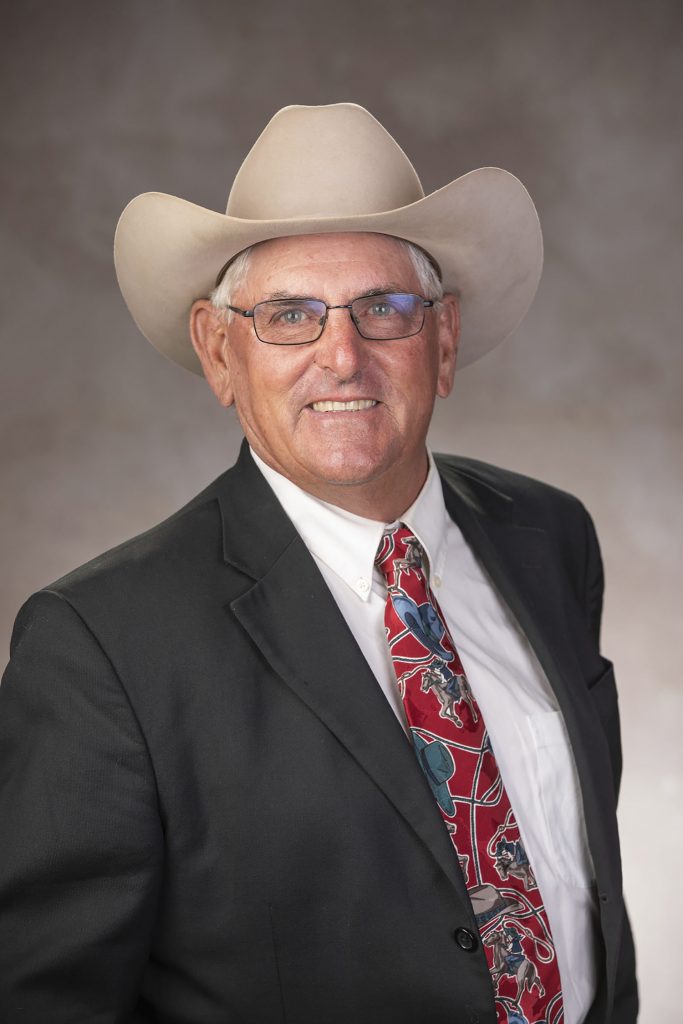
Steve Arnold’s family roots date back over 100 years on the Arnold Ranch, where his great-grandparents, Thomas and Josephine Arnold, settled in 1919.
“My great-grandfather came here from Nebraska in 1913 into Santa Margarita,” Arnold explained. “He came out to Pozo looking to make his fortune in real estate because the road here, the Old Highway 178, goes through Bakersfield out to Ridgecrest, so it was the only road accessing the coast.”
Arnold said his great-grandfather lost the ranch during the Great Depression after subdividing and selling off pieces, but his grandfather bought it all back, and after running cattle during the buildup to World War II, quadrupled the size of the ranch over 10 years.
Growing up, Steve farmed Sudan hay and barley for his grandfather and thought he would always work in agriculture. At age 21, the chance came to manage the La Panza Ranch in Carrisa Plains, and Steve and his wife Debbie left Cal Poly, got married and started ranching.
“We didn’t have a horse trailer, so I staged those horses,” Steve recalled from his days at La Panza Ranch. “The ranch was 16 miles long, and there is a cow camp corral right in the middle, so I left horses at the cow camp and horses at the headquarters. When I’d leave, I’d make those circles, change horses at the camp, and come back the other way home. That’s way back, old-school stuff,” Arnold remembered with a laugh.
After the La Panza Ranch ownership changed, Steve worked at the sales yard in Templeton for a year under Dick Nock. “Dick gave me experience at the sales yard and taught me a lot of lessons, Arnold said. “Number one, I learned I didn’t want to be up at the sales yard! The hours were long, I think I had 12 hours off a week.”
After spending a couple of years on a ranch in San Simeon, Arnold spent a decade working for Bob Morrison at Camatta Ranch. It was this work experience that put him on a path of leadership in the agriculture industry.
“Bob Morrison was always taking me to Cattlemen’s meetings, and that’s when I met California Cattlemen’s Association Executive Director John Brawley,” Arnold said. “John had been in the California Agricultural Leadership Program, and he encouraged me to apply for the next class. What he didn’t tell me was that the application packet was like 30 pages long, and so I said to heck with it. Well, months passed, and Brawley found out I hadn’t submitted my application, and he chewed me up and down! I told him I would consider applying next year, and I did.”
In 1989, Arnold was accepted into Class 20 of the leadership program. “Ag Leadership launched this whole journey for me,” Arnold maintained. “From all the places our class travelled and all the people I met in farming and ranching, I started to understand why it’s so important to get involved and be an advocate.”
His extensive record of volunteer leadership included serving as President of the San Luis Obispo County Farm Bureau from 1995-1997, California Farm Bureau board member from 2010-2016, and President of the San Luis Obispo County Cattlemen’s Association from 2015-2016.
Steve Arnold said he was fortunate to have several mentors that influenced his career and industry leadership journey. “My dad and grandad had a big influence on me obviously, but also guys like John Lacey, Alex Madonna, Darrell Twisselman, Bob Morrison, John Brawley and others.”
He was appointed by Governor Arnold Schwarzenegger to the California Mid-State Fair Board of Directors and served as President in 2010. In 2015, Steve Arnold was inducted into the Mid-State Fair Hall of Fame.
Around 1991, the Arnolds left Camatta Ranch and built a house on the family ranch in Pozo.
In 1995, Steve connected with the Robert Mondavi wine group after planting his first vineyard. The day the Mondavi representatives came to look at their field of grapes, weather conditions were unusually favorable for growing grapes in Pozo—85 degrees with a wall of fog from the coast. “I had a contract in my mailbox three or four days later,” Steve said with a laugh. “But it took me a few weeks to sign it, because I’m thinking, shoot, I have no clue what I’m doing. I had never touched a grape other than to eat one.” The Arnolds grew grapes for Mondavi for ten years.
When the grape market started to slide around 2002, Steve’s son Joey started making his own wine with a friend from college. “I sent Joey a ton of Zinfandel grapes, and it turned out pretty good. The next year we launched our wine label.”
Steve’s wife Debbie intended to get involved at the winery after selling her longtime preschool business, but instead unexpectedly got drafted into a public service career with Mike Ryan. She then worked for Assemblyman, and later Senator, Sam Blakeslee, before being elected to her current role as a County Supervisor.
The Arnold’s two children, Joey Arnold and Michelle Pascoe, returned to the family ranch business after graduating from Cal Poly, San Luis Obispo, along with their spouses Jessica Arnold and Ryan Pascoe.
Today, Arnold stays busy as a board member of the San Luis Obispo County Cattlemen’s Association, Second Vice President of the California Cattlemen’s Association, and as a member of Rancheros Vistadores. He enjoys working alongside his family raising commercial beef cattle, forage hay and quarter horses, producing estate wine for their “Vintage Cowboy Winery” brand, managing a fencing business, and spending time with his four granddaughters.
“If you go back and look at the past winners of Cattleman of the Year, it’s a pretty big honor,” Arnold said. “My dad is on that list, my Aunt Jo Ann (Switzer) is also on it, and so many others that I respect.”
San Luis Obispo County Cattlemen’s Association has given the Cattleman of the Year award annually since 1963, making Arnold the 57th person to receive this honor.

